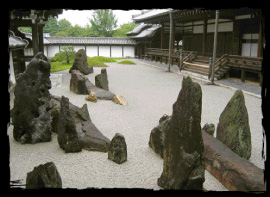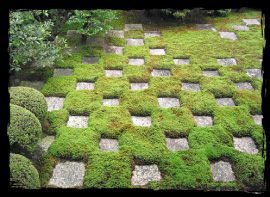 |
 |
A garden combining four different styles in one |
 |
| |
In the Hojo (the abbot’s quarters) in the center of the temple grounds, there is the Hojo garden, also known as the Hasso-no-niwa Garden, which is probably the only one of its kind in Japan. If you walk around the Hojo, you will see that the design of this karesansui style rock garden varies when viewed from the north, south, east and west.
This garden was constructed by the Showa Period (1926-89) gardener Shigemori Mirei, who built gardens not only in Kyoto, but also in areas all over Japan. The garden at Tofuku-ji Temple is considered a good example of the works Shigemori produced in his early period, and it is said to represent the Shakajodo, the path to enlightenment, the path that Shakyamuni took to become the Buddha.
Each of these four gardens is based on the conventional karesansui rock garden style, employing white sand, stones, and moss, but the expression varies due to Shigemori's own unique viewpoint. The South Garden, located in front of the Hojo is the largest of the four gardens, and it employs large stones and artificial hills to project the image of an environment for gods and unworldly sages. In contrast to this orthodox garden, the North Garden employs a checkered pattern of stones and moss to produce an impressive effect. The West Garden uses a web of dwarf azaleas and sand with a checkered pattern on a larger scale. The East Garden employs sand and column stones to create a small universe representing the seven northern stars of the Big Dipper.
As expected from its name, literally the "garden with eight aspects," the Hasso-no-niwa Garden is a novel and charming Hojo garden. Come and enjoy the views yourself. |
| |
|
|
 |
 |
| South Garden |
|
 |
 |
| North Garden |
|
|

